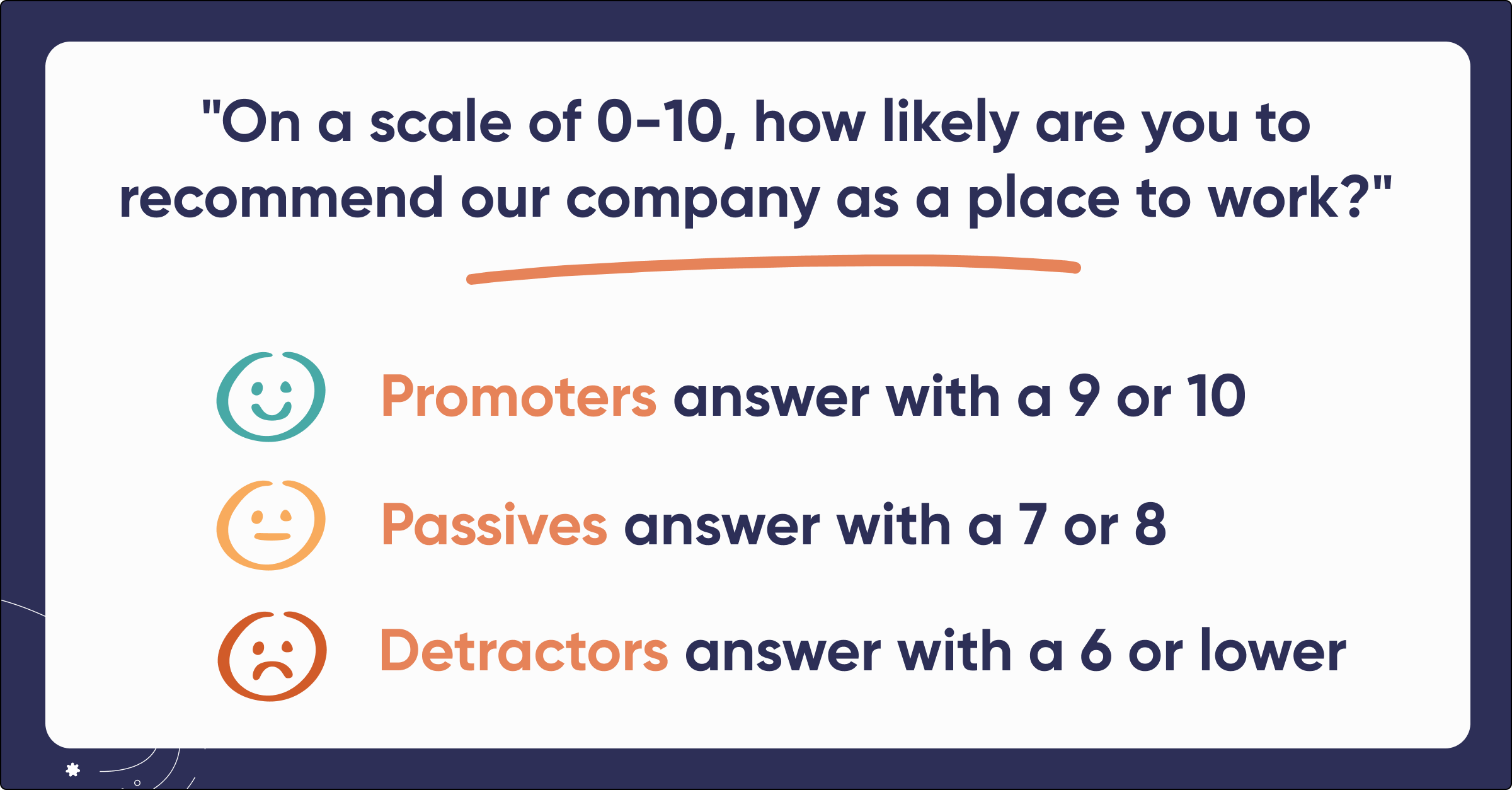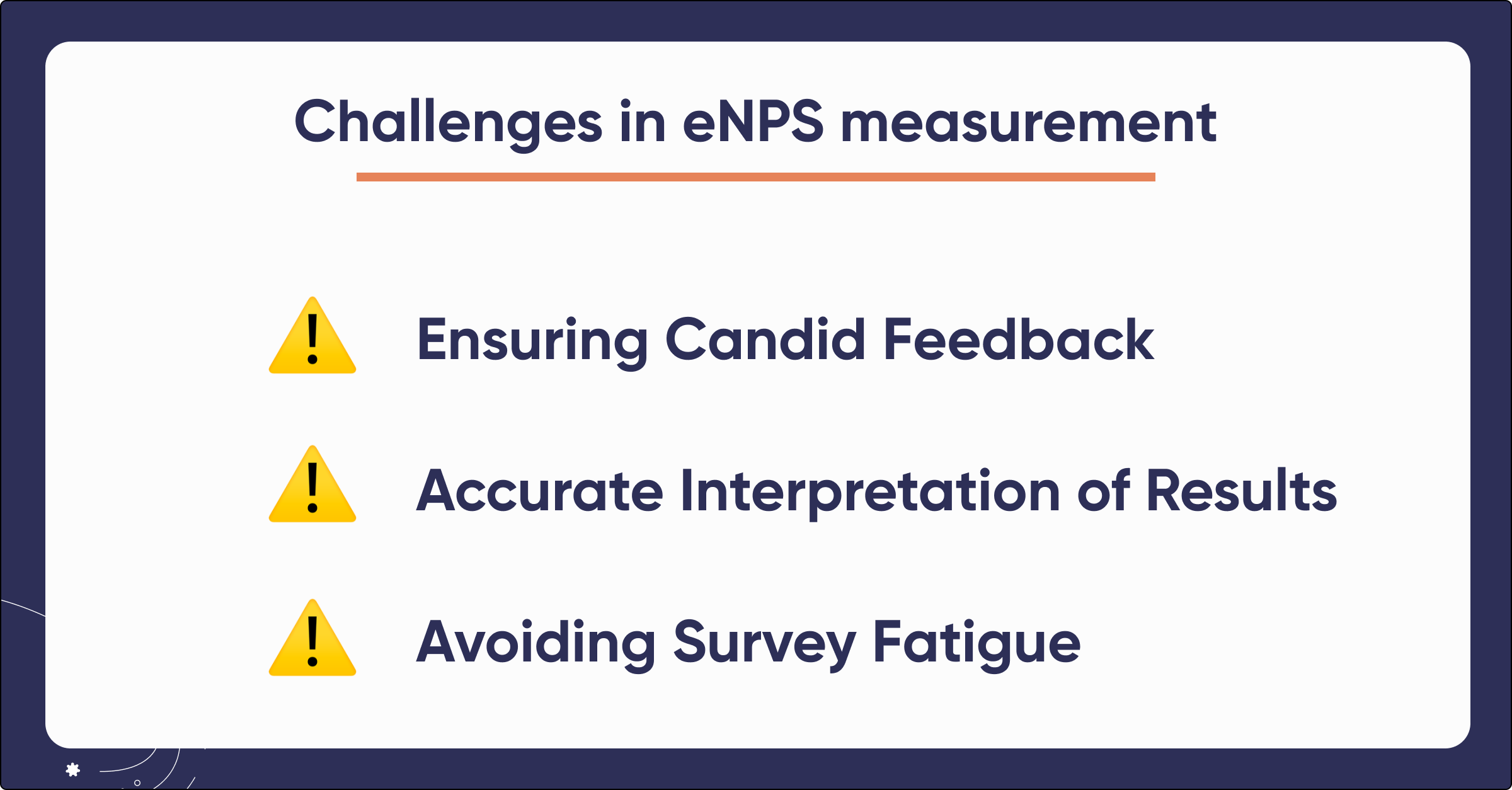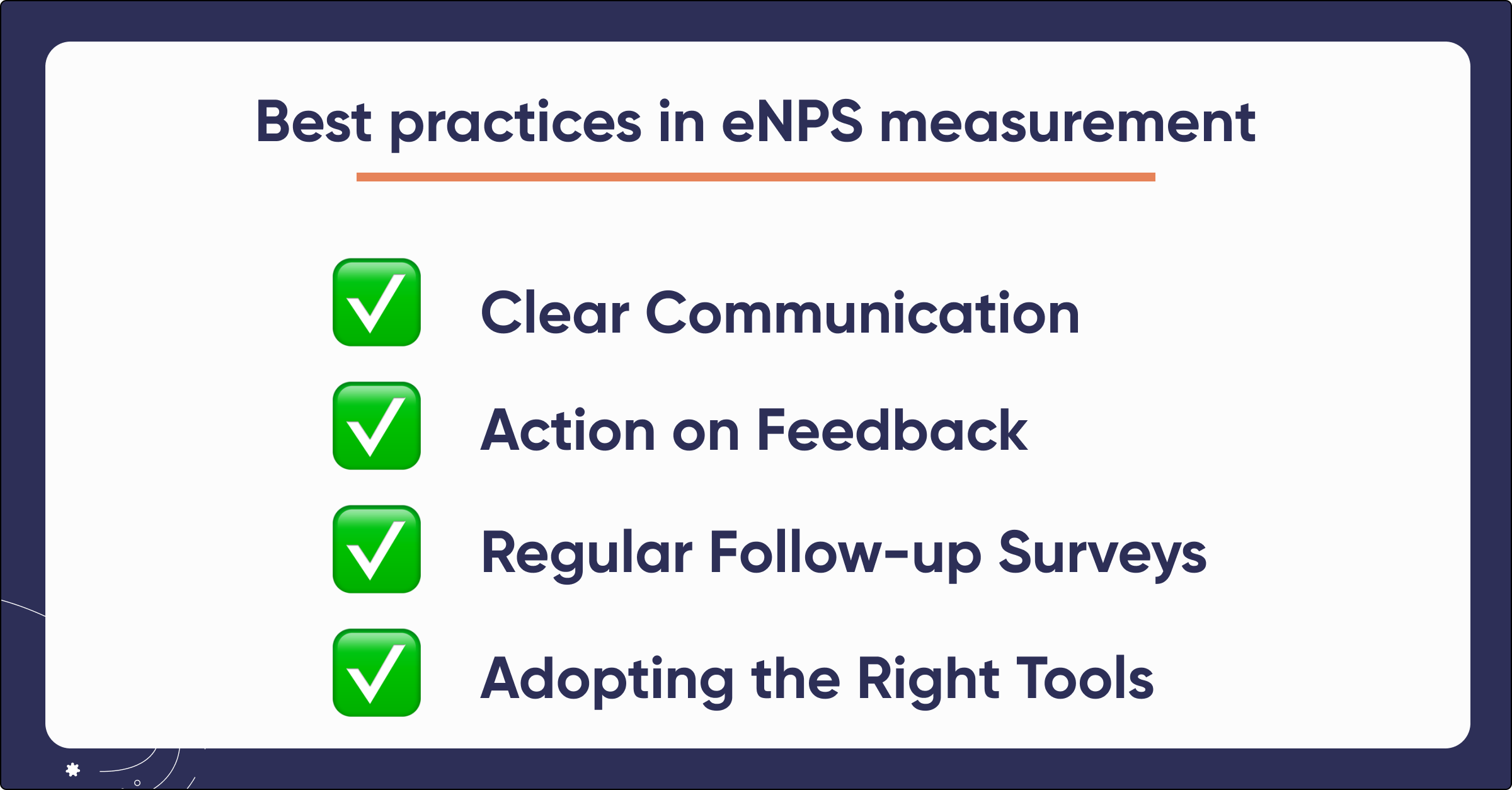Understanding eNPS: A Comprehensive Guide for Businesses
February 2, 2024The Employee Net Promoter Score (eNPS) is a tool offering insights into employee satisfaction and loyalty. This guide delves into the essence of eNPS, its importance, benefits and limitations, as well as practical ways for businesses to use it effectively.
Table of Contents
- Introduction
- What is eNPS?
- The Importance of eNPS
- How to Effectively Measure eNPS
- Benchmarks for eNPS
- Strategies for Improving eNPS
- Challenges in eNPS Measurement
- Best Practices in eNPS Measurement
- The Future of eNPS
- Conclusion
1. Introduction
The Employee Net Promoter Score (eNPS) is a tool offering insights into employee satisfaction and loyalty. This guide delves into the essence of eNPS, its importance, benefits and limitations, as well as practical ways for businesses to use it effectively.
2. What is eNPS?
eNPS stands for Employee Net Promoter Score, a metric derived from asking employees a single question: “On a scale of 0-10, how likely are you to recommend our company as a place to work?”. Based on their responses, employees are categorized as promoters, passives, or detractors.
- Promoters are those answering with a 9 or 10.
- Detractors are those who respond with a score lower than 7.
- Passives are those who gave a score of 7 or 8 and are only counted in the total sum of responses.
The formula for calculating the Net Promoter Score is: (Promoters - detractors) / total number of respondents. This means that possible Employee Net Promoter Scores range from -100 to 100.
This simple yet powerful tool provides a snapshot of employee loyalty and engagement.

3. The Importance of eNPS
eNPS can be very useful for businesses seeking to understand and improve their workplace environment. It serves as a barometer for employee sentiment, impacting factors such as retention, productivity, and overall company culture.
High eNPS scores are often correlated with a positive work environment and a committed workforce. Some studies have even found that companies with highly engaged employees also deliver better business results.
Conversely, low eNPS scores often correlate with organizational performance issues such as high employee turnover, absenteeism, and low productivity.
4. How to Effectively Measure and Interpret eNPS
Effective eNPS measurement involves ensuring anonymity to encourage honest feedback, choosing the right frequency for surveys to avoid fatigue, and framing the question in a clear, unbiased manner. Regular measurement allows for tracking changes over time, providing valuable insights into the impact of workplace initiatives.
However, it is important to note that simply looking at your eNPS score does not provide enough context about the reasons behind your particular score, or how to improve it. It is also important to understand the employee engagement metrics affecting your NPS score and measure them as well.

Teamspective’s research has shown that there are 8 employee engagement themes that alone predict approximately 56% of positive and negative changes in eNPS. In the order of significance, they are:
- Motivation
- Fairness
- Learning
- Clarity of goals
- Help and support
- Workload
- Dependability
- Psychological safety
In addition to measuring the above mentioned themes, analyzing eNPS involves understanding the proportion of promoters, passives, and detractors within your workforce. This categorization helps identify the overall employee engagement level and high-level employee sentiment. A high number of promoters indicates strong employee loyalty, while a significant presence of detractors may signal underlying issues.
For more detailed information about what affects eNPS scores the most, see our blog post “How to take control of your eNPS score?”.
5. Benchmarks for eNPS
What kind of eNPS score can be considered good? Typical benchmark values are as follows:
- Top performers, regardless of industry, typically have an eNPS score above 80.
- An excellent score is typically between 50 and 70.
- A good score is between 10 and 30.
An eNPS score of around zero means there are an equal number of promoters and detractors. This can be considered a neutral score.
Scores that can be considered poor are as follows:
- An eNPS score of -10 to -20 can be considered a poor score.
- An eNPS score below -30 can be considered extremely bad and you should take immediate action to raise the score.
It is important to note that benchmark values can vary based on industry and company size, so be sure to compare your results to businesses of similar size in similar industries.
6. Strategies for Improving eNPS
To improve eNPS, focus on addressing concerns highlighted by detractors, engaging passives to convert them into promoters, and reinforcing positive aspects that promoters appreciate. This can include actions such as:
- Measuring employee engagement frequently: Use pulse surveys to maintain a constant overview of how the attitudes in your organization are developing. This also allows you to address issues more rapidly, before they escalate.
- Fostering open communication: Encourage open and honest dialogue between employees and management.
- Improving employee recognition: Regularly show appreciation and reward employee achievements and contributions.
- Promoting work-life balance: Implement policies and benefits that support a healthy work-life balance.
- Offering professional development: Provide opportunities for career growth and skill enhancement.
- Addressing employee feedback and empowering team leads: Actively respond to feedback obtained through eNPS surveys and empower team leads to address issues in their own teams by using engagement data.
- Supporting employee well-being: Focus on mental and physical health initiatives for employees.
7. Challenges in eNPS Measurement

Ensuring Candid Feedback
One of the primary challenges in eNPS implementation is ensuring that employees feel comfortable providing honest feedback. There can be a fear of repercussions if negative feedback is traced back to an individual. To mitigate this, it’s crucial to maintain anonymity and create a safe space for honest expression.
Accurate Interpretation of Results
Interpreting eNPS results can be complex. A score alone might not provide the full picture of employee sentiment. It’s important to understand the context and the reasons behind the scores to gain meaningful insights.
The eNPS score doesn’t tell you what exactly you should do either. A low eNPS doesn’t explain what is wrong. It can be very frustrating to see a declining score and not to understand how it can be improved.
Avoiding Survey Fatigue
Another challenge is avoiding survey fatigue. Over-surveying can lead to disengagement and unthoughtful responses. Striking the right balance in survey frequency is essential to keep employees engaged and willing to provide valuable feedback.
8. Best Practices in eNPS Measurement

Clear Communication
Clearly communicate the purpose of eNPS surveys to employees. Explain how their feedback will be used and the measures taken to ensure confidentiality. This builds trust and encourages participation.
Action on Feedback
Actively responding to the feedback received is crucial. Employees need to see that their opinions are valued and can lead to real change. This involves addressing negative feedback and working on the areas highlighted by employees.
Regular Follow-up Surveys
Conducting follow-up surveys is important to track progress and understand the impact of any changes made. This demonstrates a commitment to continuous improvement and helps maintain an ongoing dialogue with employees.
By addressing these challenges and adhering to best practices, businesses can effectively leverage eNPS to enhance employee satisfaction and loyalty.
Adopting the Right Tools
Adopt tools that allow you to measure different aspects of employee engagement along with eNPS. While eNPS surveys can be done manually, this has limited actionability. Modern solutions like Teamspective allow companies to establish a holistic approach to improving eNPS and employee engagement as a whole.
9. The Future of eNPS
Technological advancements are set to enhance eNPS implementation, with AI and machine learning offering deeper insights into employee sentiment. The future of eNPS lies in its integration with comprehensive employee engagement strategies, adapting to diverse and evolving workforce needs.
Building these solutions in-house will not make sense from a resource and time-investment perspective for most organizations. Fully taking advantage of these new technologies means working with the right partners and software solutions, as they can make implementation easier and the results much better.
Read more about how Teamspective integrated science in building robust employee engagement solutions in our whitepaper.
10. Conclusion
eNPS is a powerful metric for gauging employee loyalty and satisfaction. Effectively measuring and responding to eNPS can lead to a more engaged workforce and a robust organizational culture. At the same time, it is crucial to remember that eNPS metric itself provides very limited actionability and is most valuable when used together with other employee engagement measurement methods.
By understanding and leveraging eNPS, businesses can foster a positive workplace environment that drives success. Learn how Teamspective can help you measure eNPS along with other crucial employee engagement metrics:
- Teamspective pulse solution: https://teamspective.com/solutions/engagement/
- Get in touch with our experts: https://teamspective.com/book-a-demo?from=blog©Context=get-in-touch



